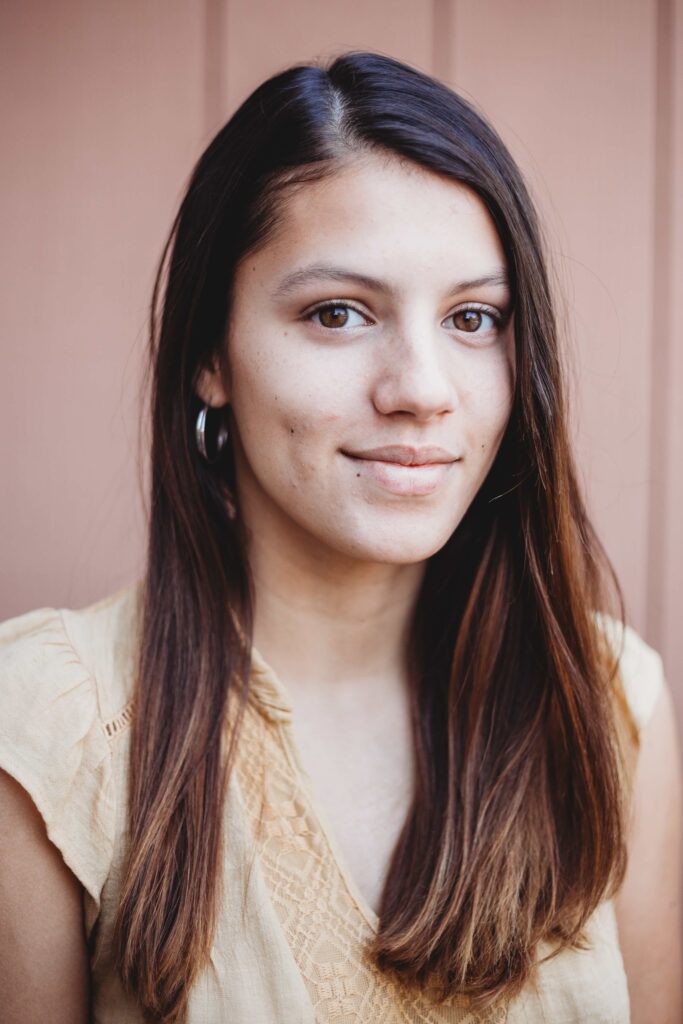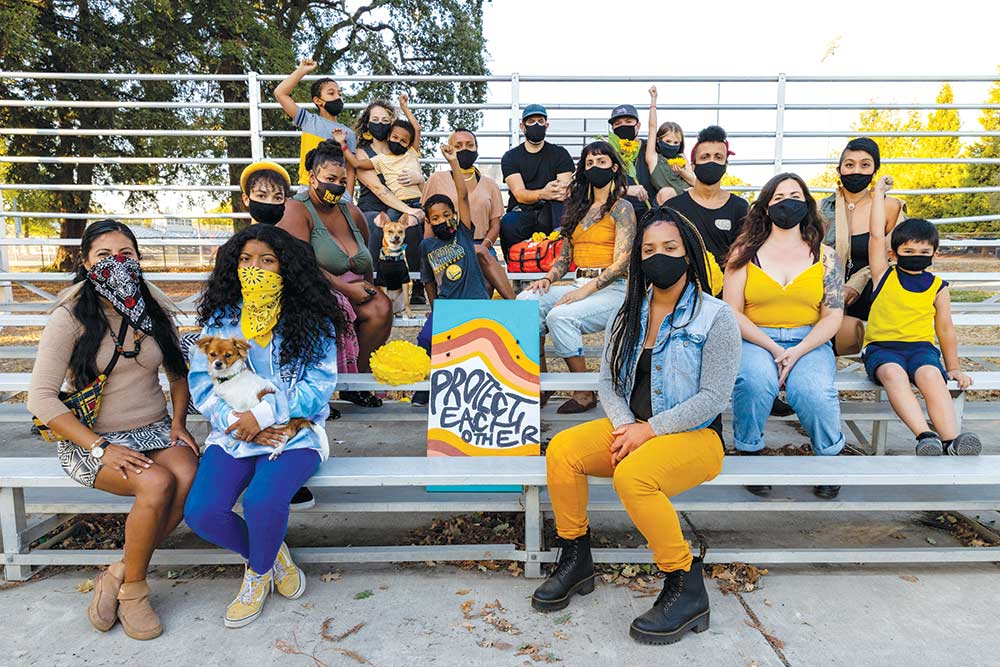By Chelsea Kurnick and Nikki Silverstein
North Bay communities will continue to have urgent needs which aren’t always solved by filling in the right bubbles once every few years.
So, while the election results come out in the days and weeks ahead, we wanted to highlight the work of North Bay activists who have been advocating for social change over the past six months.
How Activists Hold Each Other Up
In the five months since Minneapolis police killed George Floyd, activists throughout Sonoma County have organized sustained protest efforts against police brutality and in support of racial justice for Black and Indigenous people of color (BIPOC). Protests and mutual aid events—sometimes multiple events on a given day—have been held nearly every week for the 20 weeks since Floyd’s May 25 death. Marches, rallies, vigils and community care days persisted despite August’s LNU Lightning Complex Fire, September’s Glass Fire and the ongoing Covid-19 pandemic.
Floyd’s death and other instances of police brutality nationwide catalyzed Sonoma County’s own protest movement, but aren’t its only focus. Local demands also include increased police oversight, shelter and other resources for unhoused people, and mental healthcare.
The duration and breadth of this year’s protests are remarkable for the semi-rural county. Strong support networks and deep friendships are critical factors contributing to the organizers’ success.
“To be effective with community organizing, it takes a relentless effort that consumes a lot of physical, mental and emotional energy,” says Evan Phillips, a Santa Rosa parent and activist. To maintain that energy, it’s crucial to maintain a support network, Phillips and other Sonoma County activists told the Bohemian/Pacific Sun.
Organizers Tavy Tornado, 32, and Joy Ayodele, 19, met in late May after separately organizing two of Santa Rosa’s first Black Lives Matter protests of 2020. Tornado says they quickly realized they had a strong connection and common goals of catalyzing progress. The two now describe each other as sisters. When they aren’t sharing a megaphone, they’re often showing care for one another in quieter ways, whether it’s Tornado cooking for Ayodele or Ayodele taking Tornado’s child to a pumpkin patch.
“Joy is a leader of her generation and I, mine,” Tornado says. “We bridge gaps. Culturally and with community.”
Jelly Washington, a Black mother, says her five-year-old son Kamari urged her to take him to local protests after he heard what happened to Floyd.
“I come from a rough background and was often ignored or turned down for things that would have given me a better chance at life,” Washington says. “I don’t want my son to be criminalized for his lack of needs met … I want him to know how to use his voice.”
Washington says that she and Kamari were pretty much alone before the community came together around them. She says her fellow activists have supported her and Kamari physically, emotionally and through crowd-funding, without which she says she doesn’t know how she would have made it through the pandemic.
Kimmie Barbosa, a Latinx woman who grew up in Fresno, says she has been organizing in Sonoma County for 10 years but has never, before this summer, developed the deep friendships and BIPOC community support that now surround her.
Of the years leading up to this movement, Barbosa says, “It felt so isolating being in a predominantly white space that has a narrative predominantly pushed by older white people.”
Barbosa is amazed that this year’s protests have brought vast numbers of racially diverse teenagers into the streets. She calls the job loss and school closures prompted by Covid-19 an unfortunate chain of events that have been devastating in many ways, but says that they have also brought a lot of beautiful people together to fight hard for their community. She expresses gratitude for the people working behind the scenes, describing people who excel at marketing, fundraising, rounding up equipment for a rally or collecting material goods for people in need.
Despite the fatigue many feel, everyone the Bohemian spoke to wants to see the movement continue beyond the 2020 election.
Tornado says, “My hope is that this movement changes the humanitarian blueprint of Sonoma County to acknowledge what it means to keep BIPOC safe.”
Marin Activist Fights for Racial Justice
A group of young Marin activists from Police-Free Schools Marin recently had a huge racial justice win by successfully lobbying the San Rafael Board of Education to remove sworn police officers, known as school resource officers (SROs), from all San Rafael campuses. The group’s ongoing efforts now focus on urging the Novato Board of Education, where they recently organized a sit-in, and the Tamalpais Union High School District to also scrap the controversial SRO program, which disproportionately targets people of color and people with disabilities.
Zianah Monroe, 18, is one of the group’s activists working to achieve racial equity in a predominantly white county.
The Fairfax resident’s desire for change comes from her own experience of being a woman of color raised in Marin. While her father is of European descent and was born in the United States, her mother is Malay and grew up in Singapore. Monroe was raised as a follower of Islam; however, she no longer identifies with a particular religion.
“It’s quite impossible to grow up in Marin and not be discriminated against,” Monroe said. “A lot of people like me have had the experience of trying to find power and security in what makes them different.”
The young leader recently helped found the Marin Antiracist Coalition, an umbrella organization for 14 local advocacy groups fighting for racial equity in schools, policing practices and countywide policies. The grassroots and mostly youth-led groups support each other and share resources. The network includes Police-Free Schools Marin, Youth for Racial Equity, ICE Out of Marin, Marin City Cooperation Teams and more.

Most of Monroe’s efforts, however, go toward her volunteer work with Police-Free Schools Marin, the grassroots campaign to remove SROs from Marin County schools and reallocate the funding to equitable, trauma-informed resources. It might sound like a good idea to have an SRO on campus to protect students, but it is not, according to Monroe.
“People think SROs provide safety to schools,” Monroe said. “That’s the typical narrative even if there’s no data to support it. There is hysteria around mass school shootings. During some of the biggest school shootings in the country, the SROs waited for backup to respond. It’s what would happen if the SROs weren’t there.”
Instead of protecting students, SROs may cause harm. For people historically traumatized by police for their ethnicity, gender or race, having an SRO on campus feels threatening.
“A lot of people are afraid of police,” Monroe said. “I don’t think they [the police] have any business being in our schools.”
In addition, many students receive their introduction to the juvenile and criminal justice systems when they are arrested at school. These arrests disproportionately affect people of color and people with disabilities, Monroe says.
Monroe’s collaborative article about the school-to-prison pipeline appears in the current issue of Marin Lawyer magazine, a publication of the Marin Bar Association. In it, she writes that Black students are more likely than their white peers to be suspended, expelled or arrested for the same behaviors. A former San Rafael student was arrested for allegedly stealing five dollars, according to the article.
Rather than punitive measures, Monroe advocates for restorative justice, which consists of determining the root of the problem and having all parties involved decide together how to handle it. It’s not often practiced in Marin schools, but the program has been effective in Oakland.
Monroe, who graduated from High School 1327 (formerly Sir Francis Drake High School) this year, says her work is just beginning. She plans to continue pouring energy into advancing race equality.
“Marin is the most racially disparate county in California,” Monroe said. “We’re supposed to be more progressive, more liberal and more environmentally conscious, but we’re not even a sanctuary county. Immigrants are handed over to ICE. Marin City has been abandoned by the rest of our affluent county. The Marin Board of Supervisors ignores us.”
Monroe would like to see more participation from white people in the community to help resolve these issues. Engagement means more than placing a Black Lives Matter sign on the lawn, she says.
“It’s about showing up in non-performative ways and lending efforts in more tangible ways,” Monroe said. “It’s not only about money, because there are other resources we need, like political influence and legal support.”
Monroe suggests taking direct action by getting involved in activities, such as marches, Zoom meetings and emailing elected officials.
Luckily for residents of Marin, Monroes’ youth-led groups welcome people of all ages.
“We are always happy to bring on more people,” Monroe said.











